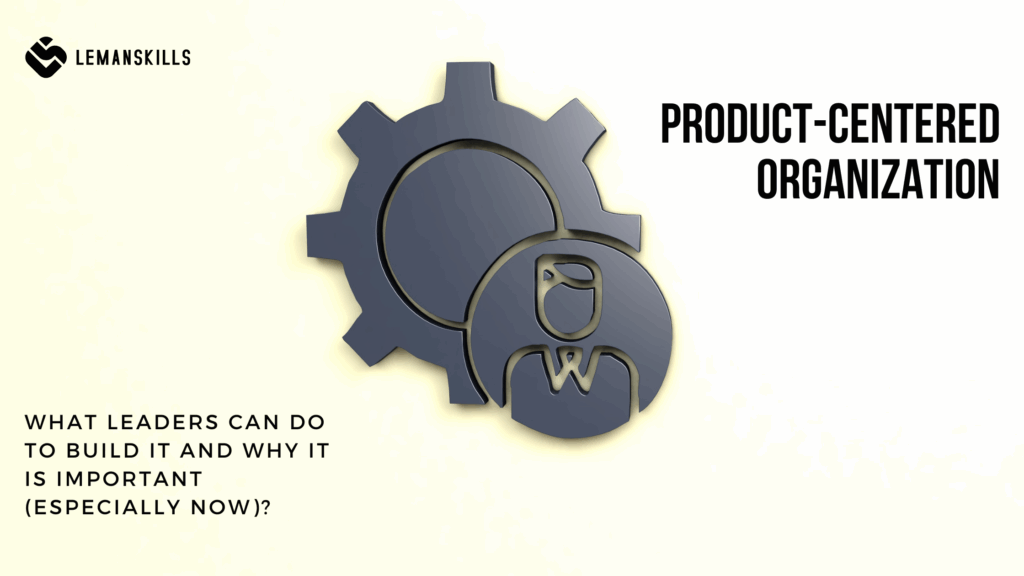In the tech world, it’s easy to get caught up in the latest innovations, algorithms, or cutting-edge frameworks. As leaders, we often pride ourselves on our deep technical expertise. However, even the most advanced technology can’t save an organization if it’s not aligned around the product—a product that solves real customer problems, delivers value, and drives the company’s success.
Yet, many leaders struggle to build a product-centered organization. Why? Because it requires more than technical know-how. It demands a set of “power skills”—social skills like communication, problem solving or collaboration—that many tech leaders have not prioritized in their own development. These skills are the foundation of Communication Intelligence (CQ), which is essential for creating an environment where people thrive and want to stay longer in their careers.
So, how do we build a product-centered organization? Why is product focus so critical? And what do we, as leaders, need to do to make it happen? Let’s dive in into that today.
Why Product is the Heart of Your Organization?
At its core, every company exists to deliver value. Whether you’re building software, hardware, or services, your product is the vehicle that delivers that value to customers. A strong product focus ensures that every team, from engineering to marketing to customer support, is aligned with the same goal: creating something that solves real problems and delights users.
When organizations lose sight of the product, chaos happens. Teams become siloed, with each department prioritizing its own metrics and goals instead of working together toward a shared vision. Engineers might focus on writing code without considering user needs. Marketing and sales teams might overpromise features that don’t exist. Customer support might be left out of the loop entirely, unable to provide meaningful feedback to improve the product.
The result? A fractured organization that frustrates employees and customers alike. Without a clear product focus, employees lose motivation because they don’t see how their work contributes to the bigger picture. Customers churn because their needs aren’t being met. And ultimately, the company’s bottom line suffers. Sounds familiar? Anyone ever experienced that kind of reality?
The Leadership Role in Building a Product-Centered Organization
As leaders, it’s our job to create an environment where teams are aligned around the product and empowered to deliver their best work. But this doesn’t happen by accident. It requires intentional effort and a specific set of leadership skills—skills that go beyond technical expertise.
I know that for some of you it’s way out of your comfort zone, but growing those skills is a must, not a luxury. IF you want to be a leader that people don’t hate. The choice is always yours.
#1 Communication Intelligence (CQ)
At the heart of a product-centered organization is strong communication. Leaders with high CQ understand how to communicate clearly and efficiently across teams, breaking down silos and ensuring everyone is aligned. The understanding the bigger picture is crucial for people to work together, focused on what is important and bringing us all closer to achieving our goals.
High CQ leaders:
– Actively listen to feedback from all levels of the organization.
– Communicate the “why” behind decisions so teams understand their purpose.
– Create a real space for the open dialogue so employees feel comfortable sharing ideas, discussing bottlenecks and solutions to the problems that appear.
#2 Visionary Thinking
A product-centered organization starts with a clear vision. The product should make a real change and solve a real problem that bothers clients. As a leader, you need to articulate what success looks like for your product and inspire your teams to go with that vision. This means being able to zoom out and see the big picture while also understanding the details that drive execution.
#3 Cross-Functional Collaboration
No single team owns the product—it’s a collective effort. Leaders must break down silos and encourage collaboration across engineering, design, marketing, sales, and customer support. This requires building bridges between teams and fostering a culture of mutual respect and shared responsibility. A great solution to implement when there are any issues with collaboration between certain teams is to shift their leaders for a while. For example, sales and marketing team is not working together very well (common issue). So, a marketing lead becomes a sales lead for a month and the other way around. That way they get to know exactly what those teams are dealing with daily and thanks to that starting building bridges, instead of fighting each other. It’s one of the ideas of Ben Horowitz and I personally love it.
#4 Understanding for Customers and Employees
The ability to understand what people need and why they behave in a certain way is a superpower for any leader. To build a great product, you need to deeply understand your customers’ pain points and aspirations. But empathy doesn’t stop with customers—it extends to your employees as well. By understanding their challenges and motivations, you can create an environment where they feel supported and engaged.
You know what I see often? Great tech people are designing amazing products and solutions. But then nobody buys it. And they are so surprised, frustrated and they blame everyone around them. But the truth is: You don’t design the product for yourself. You create it for people who have a certain problem to solve. That’s why you need to focus on their needs and voices more. Listen better, ask questions to understand what is underneath the surface. Go to your team and discuss it, brainstorm together so you generate the best possible solutions and start building a MVP for that. Iterate, don’t overinvest time, focus and money into a monster that can be something completely out of the interest zone of potential customers.
It might sounds difficult, but over time it becomes easier and easier. You can do it.
Addressing Bottlenecks in Your Organization
Even with strong leadership skills, building a product-centered organization isn’t without challenges. Here are some common bottlenecks—and some solutions on how to address them:
- Siloed Teams
Silos are one of the biggest barriers to a product-centered culture. To break them down:
– Encourage cross-functional collaboration through shared goals and regular communication. Create space for retrospective sessions together, so different teams have an occasion to listen and understand what different teams deal with.
– Create opportunities for teams to work together on projects or initiatives.
– Use tools like all-hands meetings, Q&A sessions or cross-team discussions to build transparency and space for people to ask questions, give feedback and recognition to others.
- Lack of Clarity
When employees don’t understand how their work contributes to the product’s success, they lose motivation. To address this:
– Clearly communicate the company’s direction and how each team fits into it.
– Set measurable goals tied directly to product outcomes.
– Regularly share updates on progress and celebrate wins.
- Resistance to Change
Change is hard—especially in organizations with fixed processes or mindsets. To overcome resistance:
– Involve employees early in the change process so they feel ownership. Take care of the communication that is often neglected in the change management process but then we need to pay a huge communication debt (that sometimes we cannot afford).
– Provide training and other learning resources to help teams adapt. A sense of having competences is one of the most important things that build an intrinsic motivation in people.
– Lead by example—show that you’re committed to the new way of working. Answer questions, encourage to try new things, to make pivots if needed. People need to have a real environment for making mistakes, learning and doing things better. Not the fake one.
Creating an Environment People Don’t Want to Leave
Ultimately, building a product-centered organization isn’t just about delivering great products—it’s about creating an environment where people want to stay and grow. When employees feel connected to their work, supported by their leaders, and aligned with a shared purpose, they’re more likely to be engaged and… happy.
As leaders, we have the power—and responsibility—to shape that environment. By developing our CQ and other power skills, we can improve collaboration, common understanding and innovation across our teams. And in doing so, we can build organizations that not only succeed in the marketplace but also become places where people thrive.
So ask yourself: Are you focusing enough on your own growth as a leader? Are you equipping yourself with the skills needed to create a truly product-centered culture? The answers to these questions could determine not just your success—but the success of your entire organization.
Now is the time to invest in your leadership journey—and in building an organization where both products and people shine.
PS. A part of great product-centered organization is delegating tasks effectively. Do you want to have a FREE Delegation Checklist that you can grab and start using right away? DOWNLOAD IT HERE!




